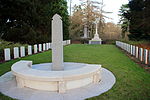Neolithic flint mines of Spiennes
Archaeological sites in BelgiumBuildings and structures in Hainaut (province)Commons category link is locally definedFlint miningGeography of Hainaut (province) ... and 5 more
History of WalloniaPrehistoric minesPrehistoric sites in BelgiumWallonia's Major HeritageWorld Heritage Sites in Belgium

The Neolithic flint mines of Spiennes are among the largest and earliest Neolithic flint mines which survive in north-western Europe, located close to the Walloon village of Spiennes, southeast of Mons, Belgium. The mines were active during the mid and late Neolithic between 4,300 and 2,200 BC. Declared to be "remarkable for the diversity of technological solutions used for extraction" the site and its surroundings were inducted into the UNESCO's list of World Heritage Sites in 2000.
Excerpt from the Wikipedia article Neolithic flint mines of Spiennes (License: CC BY-SA 3.0, Authors, Images).Neolithic flint mines of Spiennes
Chemin de Bethléem, Mons
Geographical coordinates (GPS) Address Nearby Places Show on map
Geographical coordinates (GPS)
| Latitude | Longitude |
|---|---|
| N 50.43077 ° | E 3.97879 ° |
Address
Chemin de Bethléem
Chemin de Bethléem
7032 Mons
Hainaut, Belgium
Open on Google Maps










